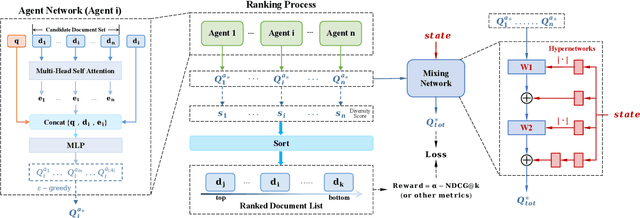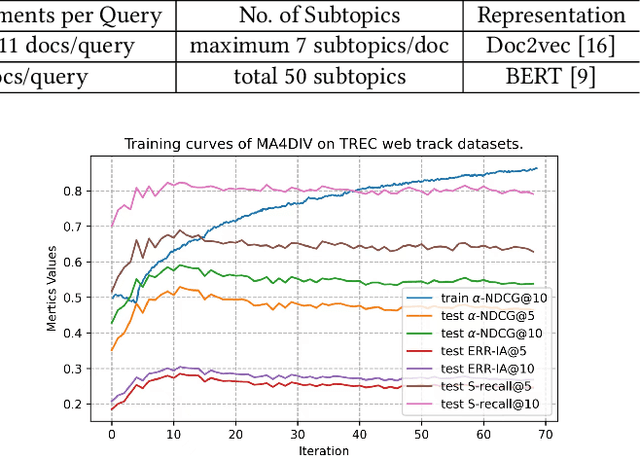Yiqun Chen
Leveraging LLMs to Evaluate Usefulness of Document
Jun 11, 2025Abstract:The conventional Cranfield paradigm struggles to effectively capture user satisfaction due to its weak correlation between relevance and satisfaction, alongside the high costs of relevance annotation in building test collections. To tackle these issues, our research explores the potential of leveraging large language models (LLMs) to generate multilevel usefulness labels for evaluation. We introduce a new user-centric evaluation framework that integrates users' search context and behavioral data into LLMs. This framework uses a cascading judgment structure designed for multilevel usefulness assessments, drawing inspiration from ordinal regression techniques. Our study demonstrates that when well-guided with context and behavioral information, LLMs can accurately evaluate usefulness, allowing our approach to surpass third-party labeling methods. Furthermore, we conduct ablation studies to investigate the influence of key components within the framework. We also apply the labels produced by our method to predict user satisfaction, with real-world experiments indicating that these labels substantially improve the performance of satisfaction prediction models.
LLM4Ranking: An Easy-to-use Framework of Utilizing Large Language Models for Document Reranking
Apr 10, 2025Abstract:Utilizing large language models (LLMs) for document reranking has been a popular and promising research direction in recent years, many studies are dedicated to improving the performance and efficiency of using LLMs for reranking. Besides, it can also be applied in many real-world applications, such as search engines or retrieval-augmented generation. In response to the growing demand for research and application in practice, we introduce a unified framework, \textbf{LLM4Ranking}, which enables users to adopt different ranking methods using open-source or closed-source API-based LLMs. Our framework provides a simple and extensible interface for document reranking with LLMs, as well as easy-to-use evaluation and fine-tuning scripts for this task. We conducted experiments based on this framework and evaluated various models and methods on several widely used datasets, providing reproducibility results on utilizing LLMs for document reranking. Our code is publicly available at https://github.com/liuqi6777/llm4ranking.
Improving Retrieval-Augmented Generation through Multi-Agent Reinforcement Learning
Jan 25, 2025



Abstract:Retrieval-augmented generation (RAG) is extensively utilized to incorporate external, current knowledge into large language models, thereby minimizing hallucinations. A standard RAG pipeline may comprise several components, such as query rewriting, document retrieval, document filtering, and answer generation. However, these components are typically optimized separately through supervised fine-tuning, which can lead to misalignments between the objectives of individual modules and the overarching aim of generating accurate answers in question-answering (QA) tasks. Although recent efforts have explored reinforcement learning (RL) to optimize specific RAG components, these approaches often focus on overly simplistic pipelines with only two components or do not adequately address the complex interdependencies and collaborative interactions among the modules. To overcome these challenges, we propose treating the RAG pipeline as a multi-agent cooperative task, with each component regarded as an RL agent. Specifically, we present MMOA-RAG, a Multi-Module joint Optimization Algorithm for RAG, which employs multi-agent reinforcement learning to harmonize all agents' goals towards a unified reward, such as the F1 score of the final answer. Experiments conducted on various QA datasets demonstrate that MMOA-RAG improves the overall pipeline performance and outperforms existing baselines. Furthermore, comprehensive ablation studies validate the contributions of individual components and the adaptability of MMOA-RAG across different RAG components and datasets. The code of MMOA-RAG is on https://github.com/chenyiqun/MMOA-RAG.
TourRank: Utilizing Large Language Models for Documents Ranking with a Tournament-Inspired Strategy
Jun 17, 2024



Abstract:Large Language Models (LLMs) are increasingly employed in zero-shot documents ranking, yielding commendable results. However, several significant challenges still persist in LLMs for ranking: (1) LLMs are constrained by limited input length, precluding them from processing a large number of documents simultaneously; (2) The output document sequence is influenced by the input order of documents, resulting in inconsistent ranking outcomes; (3) Achieving a balance between cost and ranking performance is quite challenging. To tackle these issues, we introduce a novel documents ranking method called TourRank, which is inspired by the tournament mechanism. This approach alleviates the impact of LLM's limited input length through intelligent grouping, while the tournament-like points system ensures robust ranking, mitigating the influence of the document input sequence. We test TourRank with different LLMs on the TREC DL datasets and the BEIR benchmark. Experimental results show that TourRank achieves state-of-the-art performance at a reasonable cost.
MA4DIV: Multi-Agent Reinforcement Learning for Search Result Diversification
Mar 27, 2024



Abstract:The objective of search result diversification (SRD) is to ensure that selected documents cover as many different subtopics as possible. Existing methods primarily utilize a paradigm of "greedy selection", i.e., selecting one document with the highest diversity score at a time. These approaches tend to be inefficient and are easily trapped in a suboptimal state. In addition, some other methods aim to approximately optimize the diversity metric, such as $\alpha$-NDCG, but the results still remain suboptimal. To address these challenges, we introduce Multi-Agent reinforcement learning (MARL) for search result DIVersity, which called MA4DIV. In this approach, each document is an agent and the search result diversification is modeled as a cooperative task among multiple agents. This approach allows for directly optimizing the diversity metrics, such as $\alpha$-NDCG, while achieving high training efficiency. We conducted preliminary experiments on public TREC datasets to demonstrate the effectiveness and potential of MA4DIV. Considering the limited number of queries in public TREC datasets, we construct a large-scale dataset from industry sources and show that MA4DIV achieves substantial improvements in both effectiveness and efficiency than existing baselines on a industrial scale dataset.
What's documented in AI? Systematic Analysis of 32K AI Model Cards
Feb 07, 2024Abstract:The rapid proliferation of AI models has underscored the importance of thorough documentation, as it enables users to understand, trust, and effectively utilize these models in various applications. Although developers are encouraged to produce model cards, it's not clear how much information or what information these cards contain. In this study, we conduct a comprehensive analysis of 32,111 AI model documentations on Hugging Face, a leading platform for distributing and deploying AI models. Our investigation sheds light on the prevailing model card documentation practices. Most of the AI models with substantial downloads provide model cards, though the cards have uneven informativeness. We find that sections addressing environmental impact, limitations, and evaluation exhibit the lowest filled-out rates, while the training section is the most consistently filled-out. We analyze the content of each section to characterize practitioners' priorities. Interestingly, there are substantial discussions of data, sometimes with equal or even greater emphasis than the model itself. To evaluate the impact of model cards, we conducted an intervention study by adding detailed model cards to 42 popular models which had no or sparse model cards previously. We find that adding model cards is moderately correlated with an increase weekly download rates. Our study opens up a new perspective for analyzing community norms and practices for model documentation through large-scale data science and linguistics analysis.
PDiT: Interleaving Perception and Decision-making Transformers for Deep Reinforcement Learning
Dec 26, 2023Abstract:Designing better deep networks and better reinforcement learning (RL) algorithms are both important for deep RL. This work studies the former. Specifically, the Perception and Decision-making Interleaving Transformer (PDiT) network is proposed, which cascades two Transformers in a very natural way: the perceiving one focuses on \emph{the environmental perception} by processing the observation at the patch level, whereas the deciding one pays attention to \emph{the decision-making} by conditioning on the history of the desired returns, the perceiver's outputs, and the actions. Such a network design is generally applicable to a lot of deep RL settings, e.g., both the online and offline RL algorithms under environments with either image observations, proprioception observations, or hybrid image-language observations. Extensive experiments show that PDiT can not only achieve superior performance than strong baselines in different settings but also extract explainable feature representations. Our code is available at \url{https://github.com/maohangyu/PDiT}.
Enhancing Your Trained DETRs with Box Refinement
Jul 21, 2023Abstract:We present a conceptually simple, efficient, and general framework for localization problems in DETR-like models. We add plugins to well-trained models instead of inefficiently designing new models and training them from scratch. The method, called RefineBox, refines the outputs of DETR-like detectors by lightweight refinement networks. RefineBox is easy to implement and train as it only leverages the features and predicted boxes from the well-trained detection models. Our method is also efficient as we freeze the trained detectors during training. In addition, we can easily generalize RefineBox to various trained detection models without any modification. We conduct experiments on COCO and LVIS $1.0$. Experimental results indicate the effectiveness of our RefineBox for DETR and its representative variants (Figure 1). For example, the performance gains for DETR, Conditinal-DETR, DAB-DETR, and DN-DETR are 2.4 AP, 2.5 AP, 1.9 AP, and 1.6 AP, respectively. We hope our work will bring the attention of the detection community to the localization bottleneck of current DETR-like models and highlight the potential of the RefineBox framework. Code and models will be publicly available at: \href{https://github.com/YiqunChen1999/RefineBox}{https://github.com/YiqunChen1999/RefineBox}.
Transformer in Transformer as Backbone for Deep Reinforcement Learning
Jan 03, 2023Abstract:Designing better deep networks and better reinforcement learning (RL) algorithms are both important for deep RL. This work focuses on the former. Previous methods build the network with several modules like CNN, LSTM and Attention. Recent methods combine the Transformer with these modules for better performance. However, it requires tedious optimization skills to train a network composed of mixed modules, making these methods inconvenient to be used in practice. In this paper, we propose to design \emph{pure Transformer-based networks} for deep RL, aiming at providing off-the-shelf backbones for both the online and offline settings. Specifically, the Transformer in Transformer (TIT) backbone is proposed, which cascades two Transformers in a very natural way: the inner one is used to process a single observation, while the outer one is responsible for processing the observation history; combining both is expected to extract spatial-temporal representations for good decision-making. Experiments show that TIT can achieve satisfactory performance in different settings consistently.
DATE: Dual Assignment for End-to-End Fully Convolutional Object Detection
Nov 25, 2022Abstract:Fully convolutional detectors discard the one-to-many assignment and adopt a one-to-one assigning strategy to achieve end-to-end detection but suffer from the slow convergence issue. In this paper, we revisit these two assignment methods and find that bringing one-to-many assignment back to end-to-end fully convolutional detectors helps with model convergence. Based on this observation, we propose {\em \textbf{D}ual \textbf{A}ssignment} for end-to-end fully convolutional de\textbf{TE}ction (DATE). Our method constructs two branches with one-to-many and one-to-one assignment during training and speeds up the convergence of the one-to-one assignment branch by providing more supervision signals. DATE only uses the branch with the one-to-one matching strategy for model inference, which doesn't bring inference overhead. Experimental results show that Dual Assignment gives nontrivial improvements and speeds up model convergence upon OneNet and DeFCN. Code: https://github.com/YiqunChen1999/date.
 Add to Chrome
Add to Chrome Add to Firefox
Add to Firefox Add to Edge
Add to Edge